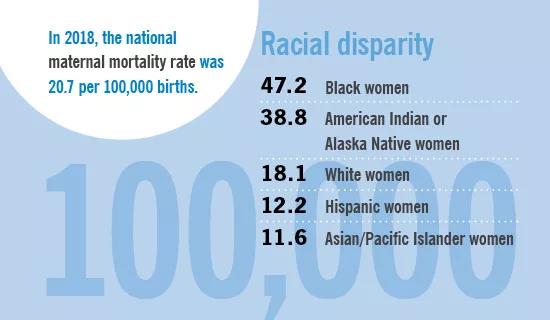Health issues in fourth trimester necessitate earlier maternal follow-up, according to new ACOG guidelines

By Linda Bloom, CNM, Susan Hudson, CNM, and Kenneth Rao, MD
Advertisement
Cleveland Clinic is a non-profit academic medical center. Advertising on our site helps support our mission. We do not endorse non-Cleveland Clinic products or services. Policy
The abysmal rates of pregnancy-related morbidity and mortality is prompting a paradigm shift in how postpartum care is delivered in the United States.

In 2018, the national maternal mortality rate was 20.7 per 100,000 births. However, there are notable racial disparities at play here. Many more women—nearly 50,000 annually—experience dangerous complications.
In May 2018, the American College of Obstetricians and Gynecologists (ACOG) released a revised Committee Opinion, recommending that postpartum follow-up appointments occur earlier in the postpartum period. The new guidance recommends that this visit take place within the first three weeks, and that it be part of an ongoing process of maternal care rather than a single encounter.
With 50 percent of all maternal mortality occurring in the postpartum period, better care for women in the fourth trimester can significantly reduce pregnancy-related morbidity and mortality.
When we think of trimesters, we tend to think about fetal development. Similarly, when we say ‘fourth trimester,’ we are referring to the response of an infant to life outside the uterus. Generally, this is the first 12-13 weeks of life. During this time, infants become more consistent with sleeping and eating patterns, and they start to self-soothe. But there’s a lot in flux for women during this time as well.
Studies show that new mothers have multiple unmet medical needs in the two months following labor and delivery, including vaginal bleeding, breast pain, changing hormones, sleep disruption, as well as changing family and professional relationships. For these reasons, organizations like ACOG are considering what the fourth trimester means to women – how their bodies change, what physical and mental health needs they have, and how best to ensure those needs are met.
Advertisement
The ACOG recommends two visits during this time frame: the first at two to three weeks postpartum and the second between four and 12 weeks following delivery, with ongoing care as needed. Visits are often scheduled within the first week for high-risk patients who had elevated blood pressure, complications or medical issues in pregnancy or delivery. At our two week visits, we address often interrelated issues including feeding and sleep, pain, voiding, blues and postpartum depression, contraception, bleeding and blood pressure.
Certainly not every patient we see at two to three weeks has postpartum depression; however, we have addressed a few cases of depression that were quite severe. When a woman has signs of (or risk factors for) postpartum depression, we refer to mental health providers.
We are exploring alternative care delivery options in an attempt to reduce barriers women may face, such as transportation or child care for their other children. We offer virtual visits, but are not seeing much response. We are still determining for whom these virtual visits will work best and in which scenarios. We also encourage our patients to use MyChart. It is a great communication tool for new mothers; they can send a message at 3:00am when they are feeling frazzled, and we are able to respond in the morning.
Medical issues in the periods of pregnancy and postpartum recovery can impact a woman’s health and wellness for her lifetime. For women who had pre-eclampsia, gestational diabetes, polycystic ovary syndrome or preterm delivery, we refer to the Women’s Cardiovascular Center. Other centers we frequently refer to include the Postpartum Care Clinic for the evaluation and treatment of third and fourth degree lacerations, the Center for Spine Health, the Center for Behavioral Health, Lactation Services and the Department of Urogynecology and Pelvic Floor Disorders. When patients return to their prenatal provider for a comprehensive postpartum visit at four to 12 weeks, they already have an entire web of support.
Advertisement
Care of pregnant women does not stop with the birth of the child. Patients with gestational diabetes and hypertension are at risk for medical complications later in life. Anticipatory guidance in the antepartum and postpartum periods can decrease the impact of these complications. This postpartum period can be a time when mothers are highly motivated to make lifestyle changes. We want our patients to get older and healthier with their children.
Advertisement
Advertisement

Women’s Comprehensive Health and Research Center addresses unmet needs

How we create obstacles for sexual, reproductive and menopausal healthcare despite our best intentions

One approved non-hormonal therapy and another on the horizon reduce vasomotor symptoms

Some post-menopausal patients may benefit from treatment

Study shows higher rates of complications, laparotomies among non-white women

Proper diagnosis and treatment require a careful mix of patient and clinical considerations

Study uniquely powered to compare adverse effects

What is female hypoactive sexual desire disorder and how is it treated?